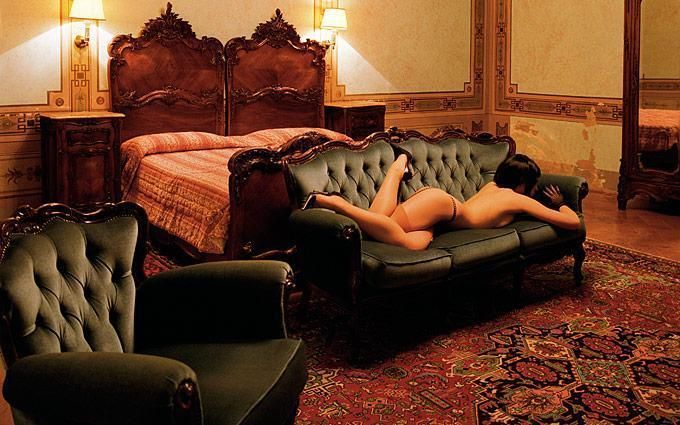
Antique rugs are made to be walked on, so don’t feel couch-bound. “Victoria on a Couch,” by Guido Argentini, color photograph, 2005. Offered by Preiss Fine Arts.
There are few elements of decor as consistently beautiful as vibrantly colored, intricately patterned antique rugs. But there’s something that feels a little counterintuitive — or just plain scary — about walking all over a rare, one-of-a-kind antique (especially one that often comes with a hefty price tag). The good news? These aged pieces were created to be durable and well-trod, and a little maintenance goes a long way. But many household practices that we’ve come to rely on — such as the use of cleaning solutions — are too harsh and aggressive for your prized antique rug.
But don’t worry. We went straight to the source and tapped three of our favorite rug experts — the folks at esteemed dealers Double Knot, Nazmiyal and Doris Leslie Blau — to help us teach us the ABCs of antique rugs, including what practices you should weave (intended) into your daily habits to ensure they have a long lifespan. Read on for their tips and tricks!
How can you tell if a rug is high quality or truly antique?
While it takes years of practice and experience to recognize an authentic, high-quality rug, there are a few things you can ask about when you’re eyeing a piece. The three main components that determine the quality of a piece are the dyes, the wool and the number of knots per square inch. Ultimately, however, if you want to be sure the rug you’re buying is truly an antique, it is best to consult an expert. As Nader Bolour of Doris Leslie Blau puts it, “It takes a connoisseur’s eye to truly understand and identify qualities of fine antique rugs.”
What materials are most common in antique rugs?
Antique rugs are primarily woven with wool, while cotton is a close second. Other materials, including silk and goat hair, are less popular but still crop up frequently in the antique market. Pro-tip: the fiber of a weave is one method experts use to determine the provenance of a specific piece.
How do these materials affect the way you care for each piece?
As long as a rug is crafted from pure materials, such as untreated wool, silk or cotton, the care won’t vary greatly. There are, however, small differences. For example, heat should never be applied to silk rugs, which are more delicate and require separate care. Stains are more visible on cotton rugs, so take extra precautions to avoid spills. Wool is the easiest to clean and therefore a great choice for high volume areas in your home.
What are the best ways to maintain an antique rug? Can you use a vacuum?
It’s normal to feel as though you need to tiptoe around antique items, but Omri Schwartz of Nazmiyal maintains that “antique rugs that are in good condition have already withstood the test of time. There is no reason why, if taken care of properly, they will not continue to survive for years and years.” While you may worry that your vacuum is too harsh for your rug, frequent vacuuming is in fact necessary to remove everyday dirt that otherwise wears down the pile. Schwartz does however stipulate that “it’s best to use an ordinary suction vacuum without bristles, as the bristles can damage the rug’s pile.”
Rotating the carpet every couple of years is also recommended — it ensures that the rug gets even foot traffic.
Are standard cleaning solutions too harsh?
One thing that all three experts agreed on is that chemical cleaners are totally off-limits. Murat Kupcu of Double Knot warns “If not used or applied correctly, [chemical formulas] may damage the rug irreparably.” Professional cleaners stick to warm water and gentle, chemical-free solutions that ensure colors won’t bleed and materials won’t break down.
How often should an antique rug be cleaned?
Your rug should be sent out once every five years for a professional clean. While regular vacuuming and spot-cleaning are recommended, a professional rug cleaner has the skills and equipment to do a full cleanse of your carpet and ensure that it dries thoroughly in a temperature-controlled setting.
What are common mistakes people make when using antique rugs in their homes?
Your home can be riddled with traps for your vintage carpet, many of which are easy to overlook. There are the obvious, like untrained pets, and the more subtle, such as too much sun exposure or placing the rug under heavy furniture.
One specific tip is to keep your eyes peeled for moths. If you happen to find one on your rug or think there may be evidence of moth damage, take your carpet to a professional — moth damage can be pernicious, and it’s best to ensure the problem is fully dealt with to minimize harm to your piece.
And most importantly? Keep your rug away from moisture. If it gets wet, prop it up and let it dry out completely before laying it back on the floor.
What type of environments are best for maintaining the quality of a rug? How can environmental circumstances affect the rug (ie. if a rug is kept in a house with smokers)?
According to Schwartz of Nazmiyal, “The best environment for a rug would be a place that is dry, without a lot of direct sunlight, not too hot, not too humid or damp and that does not get an excessive amount of daily traffic.” But many other factors (yes, even smoking in your home) won’t have a drastic effect on your carpet.
Let’s say you spill your morning coffee on your antique rug. What steps should you take?
Don’t panic! This can be fixed, which is great news for those of us who have a tendency to spill but feel we still have the right to own nice things. First, immediately blot the area of the spill. Then, place a towel or cloth under the rug and pour warm water through it until the stain rinses out. To ensure that colors don’t bleed, test a small area of the rug with a damp cloth. If color does transfer over, it’s best to leave the job to a professional rug cleaner.
Any tips and tricks for safely storing rugs?
Mothballs or cedar shavings are a must. Additionally, Schwartz at Nazmiyal recommends “wrapping [the rug] in breathable cotton fabric, not plastic.” Every two months or so, air the rug out and check to make sure the storage area is still dry and not exposed to humidity.
How do you go about repairing a damaged rug? How do you know if the damage is beyond repair?
When it comes to tears, holes and frayed edges, don’t try and fix it yourself. Consult a reputable rug dealer to find out whether or not your rug can be fixed. If they think it can be saved, have your rug dealer recommend a restorer who can bring your carpet back to life. While Kupcu of Double Knot does warn that “repair can be costly so you need to be informed of your options,” Bolour of Doris Leslie Blau maintains “If there is wear, we re-pile the area. If there is a hole, we re-weave. For sides and ends, we re-bind. Nothing is beyond repair.”




